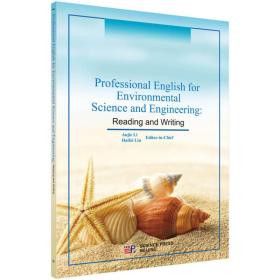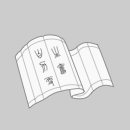
Professional English for Environmental Science aand Engineer
¥ 23.54 5.9折 ¥ 40 全新
库存3件
山东泰安
认证卖家担保交易快速发货售后保障
作者Anjie Li、Haifei Liu 编
出版社科学出版社
出版时间2017-01
版次1
装帧精装
货号604 11-28
上书时间2024-11-29
- 在售商品 暂无
- 平均发货时间 24小时
- 好评率 暂无
- 最新上架
商品详情
- 品相描述:全新
图书标准信息
- 作者 Anjie Li、Haifei Liu 编
- 出版社 科学出版社
- 出版时间 2017-01
- 版次 1
- ISBN 9787030539465
- 定价 40.00元
- 装帧 精装
- 开本 16开
- 纸张 胶版纸
- 页数 337页
- 字数 347千字
- 正文语种 简体中文
- 【内容简介】
-
本教材涵盖了环境科学与工程专业英语范文、科技英语阅读方法以及写作投稿三方面内容。采用了大量通俗易懂的科技英语范例,涉及环境化学、环境生物学、环境水力学、给排水工程、大气污染控制以及土壤污染及治理等多个领域,包括基础环境知识和前沿热点环境问题及技术,为读者了解和熟悉本专业科技英语词汇奠定基础;全面介绍了环境专业科技英语的类型、结构及特点,结说明了科技检索的主要方法,详细讲解了科技精读、泛读及略读,以及如何管理和结科技英语文献,为读者建立良好的科技英语阅读惯提供方法;围绕英语科技成功发表的关键因素,从选题、立论、写作步骤、专业写作要领、投稿流程、撰写项目申请等多方面,为读者提供完整有效的科技英语写作和投稿。
精彩内容:
1introductionofacientificreearchpaper1.1whaticience?theword“cience”ifromthelatinword“cientia”,whichmean“knowledge”.whenwepeakofcience,weuuallymeanawayofundertantheworldthroughthoughtandexperimentordecribetheefforttoundertandhowtheunivereworkthroughcientificmethod.cienceiaytematicenterpriethatbuildandorganizeknowledgebaedontetableexnationandpredictionabouttheunivere.inancienttime,“cience”referredtothibodyofknowledgeitelf.inclaicalantiquity,ciencewaatypeofknowledgethatwacloelylinkedtophiloophy.intheearlymodernperiod,theword“cience”and“philoophyofnature”wereometimeuedinterchangeably.ciencewaconideredaabranchofphiloophyuntilthe19thcentury.inmodernuage,“cience”inotonlytheknowledgeitelf,butalotheproceofpuruingknowledge.withthepaageoftime,theword“cience”habeeincreainglyaociatedwiththecientificmethoditelf,aawaytotudythenaturalworld.incethe19thcentury,theterm“cientit”habeenappliedtothoewhooughttheknowledgeandundertanofnature.generally,theword“cience”meannaturalcience.however,therearemanyrecognizedciencefield:ocience,appliedcience,formalcience,andother.modernciencecanberoughlydividedintothenaturalcience,whichtudythematerialworld;ocience,whichtudiehumanbehaviorandociety;andformalciencelikemathematicandtatitic.formalcienceioftenexcluded,atheetudiedonotdependonempiricalobervation.fromthedecriptionabove,itiobviouthat“cience”refertoknowledgethatireducedtoanalgorithmicytem,notinvolvingtheneedforindecribablekill,uchafineart.toundertandtheworldbydecribingandeningnaturalphenomena,whichwecall“cience”,cientitmakeempiricalobervation,followedbyaerieofte,toperformcientificreearch.teofthecientificmethoeneralcientificreearchareafollow:makinggeneralobervationithefirttepinthecientificmethod.fromwhatioberved,youmaygainomeideaandputforwardquetionfromwhichyoucouldmakeapredictiononwhattheoutemightbe.yourprediction,however,mayormaynotberight.oyoumuttetdifferentalternativetoyourideaothatyouranwerinotbiaed.however,oftenyoucannotdirectlytetanideaoratheory.forexample,youcannottetthetheoryofevolution,becaueevolutioniatheorythatiintangible.o,thequetionderivedfromyourideaneedtobeturnedintoahypotheithatcanbeteted.forexample,weallknowthatartifiheatinginacity,regeneratorlikebuilandroad,andthedecreaeofgreenpaceinducetheurbanheatiland(uhi)effect.wecantetthehypotheithattheuhieffectiaffectedbymanyfactoruchaunderlyingurface,airpollution,andhumanmigration,throughtudie.ifthehypotheiiupportedbythereultofthetudie,thehypotheicanbeuedtoupporttheoriginalidea.thu,ifthetudyhowthatdifferentkindofunderlyingurfacereultindifferentlevelofuhieffect,wecanconidertheunderlyingurfaceaafactorofuhieffect.withouthypotheiteting,ideaaboutnatureandtechnique(e.g.hemiphericaldomeology)aremereobervationorpeculationthatanyperoncanmake.aacientit,youcannotmakeaconcluionorclaimbaedonyourintuition,unqualifiedpeculation,oremotion.uingtheetoenomethinginotveryconvincing,andconequentlywouldnotbecientific.ciencethereforerequiregatheringevidencetoennaturalphenomena.1.2whatireearch?theword“reearch”derivefromthemiddlefrench“recherché”,whichmean“togoabouteeking”.thetermitelfiderivedfromtheoldfrenchterm“recerchier”whichiapoundwordfrom“re”“cerchier”,or“earcher”,meaning“earch”.reearchhabeendefinedinavarietyofdifferentway.martynhuttleworthgaveabroaddefinitionofreearch:“inthebroadeteneoftheword,thedefinitionofreearchincludeanygatheringofdata,informationandfactfortheadvancementofknowledge.”crewelltatethat“reearchiaproceofteuedtocollectandanalyzeinformationtoincreaeourundertanofatopicoriue”.reearchincludethreete:①eaquetion,②collectdatatoanwerthequetion,and③preentananwertothequetion.themerriamwebteronlinedictionarydefinereearchinmoredetaila“atudiouinquiryorexamination;epely:invetigationorexperimentaimedatthedicoveryandinterpretationoffact,reviionofacceptedtheorieorlawinthelightofnewfact,orpracticalapplic - 【目录】
-
Contents
Preface
1 Introduction of a scientific research paper 1
1.1 What is science ? 1
1.2 What is research ? 2
1.3 What is a scientific paper ? 4
1.4 The structure of a scientific research paper 7
2 Scientific resource search strategy 10
2.1 Introduction of subject resources 10
2.2 Literature classification 10
2.2.1 Primary literature: the source of basic ideas 11
2.2.2 Secondary literature: the source of a specific topic 12
2.2.3 Tertiary literature 13
2.2.4 “Gray”literature 13
2.3 Steps to search the scientific literature 14
2.3.1 Retrieval methods and skills 14
2.3.2 Research tools 17
2.3.3 Databases 19
3 Reading skills for scientific literature 21
3.1 Academic reading 21
3.1.1 Vocabulary for reading comprehension 21
3.1.2 How to treat difficult sentences 23
3.1.3 Note-taking 25
3.2 Four reading skills: intensive, extensive, skimming, scanning 28
3.2.1 Intensive reading 28
3.2.2 Extensive reading 29
3.2.3 Skimming reading 30
3.2.4 Scanning reading 31
3.3 A four-step guide for reading a scientific paper 32
3.3.1 Skim the article 32
3.3.2 Put forward questions 33
3.3.3 Comprehend section-by-section 34
3.3.4 Conclusions and criticism 34
4 Management and summarization of references 36
4.1 Endnote 36
4.1.1 Introduction to Endnote 36
4.1.2 Creating an Endnote Library 37
4.1.3 The management of the Endnote Library 44
4.1.4 How to use endnote for paper writing 45
4.2 BibTexMng 48
4.2.1 Operation with the reference list 48
4.2.2 Operations of the records 50
4.2.3 What is BibTeX ? 51
4.2.4 Format of bib files 52
5 Before starting to write 58
5.1 Thinking (put forward questions, evaluate your data, generate your ideas) 58
5.2 Preparation (choose an appropriate journal and consult the guide for authors) 59
5.3 Develop an outline 60
5.4 Notes before writing 63
6 Steps to write each manuscript section 65
6.1 Title page 65
6.1.1 The title 65
6.1.2 Author names and affiliations 66
6.1.3 Abstract 66
6.1.4 Keywords 66
6.2 The main body of the text 67
6.2.1 Introduction 67
6.2.2 Materials and methods 79
6.2.3 Figures and tables 84
6.2.4 Results and discussion 95
6.2.5 Conclusions 98
6.2.6 Others 99
6.2.7 Revision 101
7 Publication of scientific manuscript 103
7.1 Where to submit 103
7.1.1 Decide early 103
7.1.2 How to find appropriate journals 104
7.2 How to submit 107
7.2.1 Basic concepts 107
7.2.2 Process of submitting 112
7.2.3 How to respond to editors and reviewers 114
7.3 Publishing process 117
7.3.1 Copyediting process 117
7.3.2 Marking the corrections 118
7.3.3 Additions 120
8 How to use LaTex 122
8.1 Introduction to LaTex 122
8.2 The installation of LaTex 122
8.3 The basic grammar rules of LaTex 125
8.4 An example of using LaTex to write academic papers 126
References 135
Appendix: Example articles 136
点击展开
点击收起
— 没有更多了 —












以下为对购买帮助不大的评价